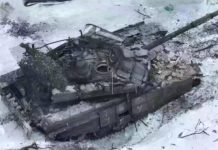Main battle tanks, as formidable land-based weapons, form an integral part of the IDF’s defense strategy, symbolizing both deterrent power and strategic military assets in wars.
The Israel Defense Forces (IDF) said on October 13 that their infantry and tanks entered the Gaza Strip in a local attack in a campaign to respond to Hamas, rescuing hostages. After the local raid, Israeli forces returned to the border. This is said to be the beginning of a larger-scale Israeli ground attack campaign against the Gaza Strip.

Main battle tanks, as formidable land-based weapons, form an integral part of the IDF’s defense strategy, symbolizing both deterrent power and strategic military assets in wars. Israel’s Armored Corps, established in the early years of the state in 1948, emerged as an important part of the Israeli army. Initially created to meet the urgent need for armored capabilities during Israel’s War of Independence, it quickly developed into a formidable force, demonstrated by its proficiency in combat.
Central to the effectiveness of the Armored Corps lies in the widespread deployment of main battle tanks, which are the backbone of its operational capabilities. Over the years, Israel has developed and put into use many advanced tank models, including the iconic Merkava series, etc., famous for its innovative design and exceptional defense capabilities. The Armored Corps is organized into multiple brigades built to accomplish specific operational objectives. These brigades are strategically deployed to carry out a variety of scenarios, from armored assaults to defensive maneuvers.

Israel’s commitment to innovation and military technological superiority is evident in its diverse tank inventory, tailored to address a variety of operational requirements. Integration of the latest military technology and continuous upgrades have ensured that the Armored Corps remains at the forefront of armored warfare, helping Israel counter evolving threats.
Israel recently announced the transfer of initial production models of the 5th generation main battle tank Merkava V Barak to units in the Israel Defense Forces. According to a statement by the Israeli Ministry of Defense on September 19, 2023, the first batch of tanks, described as “mass produced” were delivered to the 52nd Battalion of the 401st Armored Brigade. This achievement comes after half a decade of production and development activities by the Weapons Department of the Ground Forces and the Israeli Armored Corps, along with domestic defense companies such as Elbit Systems, Israel Aerospace.

Israeli Defense Minister Yoav Gallant noted: “The Barak tank is innovative – it takes our mobility to a new level and is a clear demonstration of our technological capabilities.” The Merkava 5 is an improved version of the Merkava IV that integrates the latest technologies and innovations in protection and digital combat capabilities. One of the most important improvements of the Merkqava V is the integration of the Trophy Active Protection System (APS) designed to counter the most advanced anti-tank missiles, rocket-propelled grenades (RPGs), anti-tank rockets, and high-explosive anti-tank (HEAT) rounds. The Barak is expected to replace all Merkava 4 tanks in the 401st Brigade by the end of 2025.
The Merkava Mk 4 Meil Ruach or Merkava Mark 4M. With the affectionate nickname “Windbreaker”, the Merkava Mk.4M embodies a significant leap forward in the combat capabilities of armored forces. It represents an enhanced version of the prized Merkava Mk.4 tank, demonstrating pioneering innovations in military engineering as it features the Trophy Active Protection System (APS). Mass production of Mark 4M tanks began in 2009, and the first whole brigade of Mark 4Ms was declared operational in 2011.

The Merkava Mk IV MBT. The tank began development in 1999, and production in 2004. Removable modular armor, from the Merkava Mark IIID, is used on all sides, including the top and a V-shaped belly armor pack for the underside. This modular system is designed to allow damaged tanks to be rapidly repaired and returned to the field. Because rear armor is thinner, chains with iron balls are attached to detonate projectiles before they hit the main armored hull.
Merkava Mk IV is the first contemporary tank without a loader’s hatch in the turret roof, because any aperture in the turret roof increases risk of penetration by ATGMs. Tank rounds are stored in individual fire-proof canisters, which reduce the chance of cook-offs in a fire inside the tank. Some features, such as hull shaping, exterior non-reflective paints, and shielding for engine heat plumes mixing with outside air to confuse enemy thermal imagers. Israel operates about 330 Mk4s and Mk4Ms, and about 220 are in reserve.
The Merkava Mk III version, staying true to its traditions, the Merkava Mk III remains an integral part of the IDF’s Armored Corps alongside the Merkava Mk 4. Notable is its special front-mounted engine, designed to improve crew safety. At the forefront of key engagements, Merkava III proved indispensable in the South Lebanon conflict, the Second Intifada, the 2006 Lebanon War, the 2014 Operation Protective Edge. In June 2023, local Israeli news agencies reported on the possibility of selling this main battle tank to two (undisclosed) countries, according to an Israeli Defense Ministry official. Currently 160 are in ground force service, and about 660 are in reserve.
In addition, Israel also owns older versions of the Merkava such as Mk II, Mk I, and even the Magach 7C – a tank line based on the American M48 and M60 tanks. According to reputable media, Israel possesses a formidable arsenal of tanks, with more than 2,200 tanks, of which 1,760 are ready for combat. Leading the way in the Israel Defense Forces’ armored capabilities is the highly regarded Merkava line, which includes models II, III and IV.


















